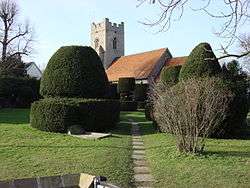Borley
| Borley | |
 Parish church of Borley |
|
 Borley |
|
| OS grid reference | TL850431 |
|---|---|
| District | Braintree |
| Shire county | Essex |
| Region | East |
| Country | England |
| Sovereign state | United Kingdom |
| Post town | SUDBURY |
| Postcode district | CO10 |
| Dialling code | 01787 |
| Police | Essex |
| Fire | Essex |
| Ambulance | East of England |
| EU Parliament | East of England |
| UK Parliament | Braintree |
Coordinates: 52°03′22″N 0°41′50″E / 52.0561°N 0.6971°E
Borley is a village and civil parish in Essex, England. It is located on the River Stour, approximately 3 km (1.9 mi) northwest of Sudbury, Suffolk and is 39 km (24 miles) north-northeast from the city of Chelmsford. The village is in the district of Braintree and in the parliamentary constituency of Saffron Walden. The parish is part of the Stour Valley South parish cluster.[1] It consists of two hamlets, Borley around the church, and Borley Green, to the east. A smaller parish, Borley Parva, was joined with Foxearth in the Middle Ages. The name Borley is compounded of the Saxon words "Bap" and "Ley", that is "Boar's Pasture". The population of the village is included in the civil parish of Cavendish.
Landmarks
There are several old buildings including Borley Hall, the fragment of a once much larger house, and Borley Place, at one time the rectory.
The church (dedication unknown) is a small building of stone originally in the Romanesque/Early English style of the late 12th and early 13th centuries. Later renovations have resulted in the mainly perpendicular style of the mid-14th to 16th centuries. The church as it now stands consists of chancel, nave, south porch and a crenellated western tower containing bells. The chancel contains a brass monument to John Durham of Norfolk (died 1601). Several tombs of the Waldegrave family are found within the structure, including a monument 14 feet high with a cornice supported by six pillars of the Corinthian order, beneath which lie full-length figures of Sir Edward Waldegrave (knighted in 1553, at the coronation of Queen Mary, died in the Tower of London on 1 September 1561) and his wife Lady Frances Waldegrave née Neville (died 1599). Both tombs bear a marginal inscription in Latin and a record of other alliances of this family. The church contains memorials to two 19th-century rectors – William Herringham and his son John Philip Herringham.
Borley is most famous for the survival of a document from 1308 listing the 'Extent' of the manor,[2] listing the main occupants and the rental income.
Borley Rectory
Borley is notorious for the 'Borley Rectory Affair', involving the supposed haunting of a Victorian rectory (now demolished). Beginning in 1929, psychical researcher Harry Price generated a story that captured the attention of the nation and convinced many of the proof of the permanence of the spirit after death. His supposed activities were reported widely by the press of that time, and Price published several popular books on the subject that brought him considerable fame. After Price's death, the story began to unravel under the scrutiny of experts from the Society for Psychical Research. The Society went through the records with great tenacity, suspecting that Price had exaggerated evidence to sensationalise events and to suggest supernatural causes for mundane phenomena. Any possible evidence of ghosts was irredeemably contaminated by Price's behaviour and the manipulation of the facts in his two books, The Most Haunted House in England and The End of Borley Rectory, produced during and immediately after the Second World War. A few reported phenomena were said to have existed before Price was called to the scene, but most of these stories seem to have originated from one of the residents of the rectory, Ethel Bull. Most former residents of the rectory claimed never to have seen anything unusual whilst they lived there.
The first full-length independent biography of Harry Price, Harry Price: The Psychic Detective by former national newspaper journalist Richard Morris. Locally based Morris unearthed a mass of previously hidden information about Price which included the fact that he was a conman who left school at 16, and lived a double-life as a paper-bag salesman and as an expert on psychic matters rubbing shoulders with the rich and famous. Before settling on the subject of spiritualism, he had unsuccessfully attempted to pose as an archaeologist and as an expert on old coins. This has led all recent investigators of Borley Rectory to treat Harry Price's book with great caution.
Price's investigation of Borley Rectory the subject of a 2013 novel, dramatised by Neil Spring, The Ghost Hunters which tells the story through the eyes of Sarah Grey, Harry's secretary.
Borley remains a place of great interest to 'psychic tourists' who frequently visit the village looking for the site of the long-gone rectory.
References
- ↑ "Parish cluster map". www.braintree.gov.uk. Archived from the original (JPG) on 14 October 2006. Retrieved 2007-02-01.
- ↑ http://www.foxearth.org.uk/BorleyFourteenthCentury.html The Extent of the Manor of Borley
External links
| Wikimedia Commons has media related to Borley. |
- Local History Website for Borley and surrounding area
- The Bones of Borley Account of the haunting
- The Extent of the Manor of Borley
- Animated film on the Borley Hauntings
- A look at modern Haunted Borley